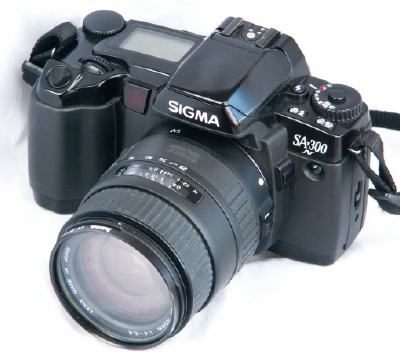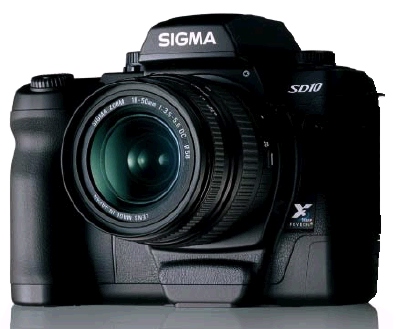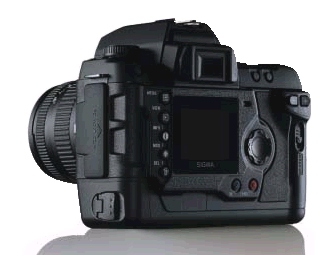Sigma SLR cameras
It's March 2005, and I'm intending to buy a digital SLR. I'd like a Sigma SD10, but with companies like Pentax and Canon introducing newer cameras at significantly lower prices, it doesn't look like such good value. I'm still trying to convince myself - but I have to admit that some of my motivation is out of admiration for the 'purist' ideas that Sigma SLRs have always stood for.
Sigma is the world's largest producer of interchangeable lenses for cameras. They have been making lenses to fit other companies' cameras since the 1960s. In 1993 they introduced their own SLR - the SA-300. It appears to me that it was inspired by the Canon designs of the day.
I bought the slightly improved SA-300N, introduced 1994. It has real photographer's features such as spot metering, bracketing, AE lock, DOF preview, mirror lock-up, and a full information viewfinder. If you bought Sigma's dedicated EF-430 Super flash you got flash exposure compensation, wireless TTL flash, second curtain flash, high speed sync and more.
Many of these features were missing from the big brands' cameras of a similar price. Budget Pentax cameras had a 2 zone metering system, the Sigma was 8 zone. And there was a budget Nikon with no shutter speeds in the viewfinder. A remote control and body-integral low-light AF assist beam were also not common on competing cameras.
It didn't have gimmicks seen on other brands such as power zoom (Pentax) and scene modes ('portrait', 'sport' etc, as on most amateur cameras. Minolta had a system where you bought little cards. Canon had a bar-code reader). For real photographer's features no similarly priced camera could touch it.
|

|
So the Sigma seemed like a dream and a bargain. But the construction feels cheaper than some - although unlike the budget Canons of the time it still had a metal lens mount. There's nothing I can truly complain about, there's nothing actually bad - but other cameras I have used (Minolta Dynax 7000i, Pentax Z-20, Pentax MZ-5) just somehow feel stronger and the switches less plasticky. And the AF system is below par. It works OK, but less quickly then the established brands. Of course the speed varies from lens to lens, but in general I would say that the speed of the motor is good, but the lens hunts several times around the final focus point. I also owned a Pentax SF-Xn and Pentax Z20, and I would say that the SA-300N is somewhere between them in AF speed.
I've heard it said that buying a Sigma system is bad because it limits you to Sigma lenses. If you bought a Minolta or Pentax or any other brand you would have access to that brand's lenses, plus Sigma's range, plus lenses from other companies such as Tokina and Tamron. But only Sigma makes Sigma mount lenses. Well that's true, but is it really an issue? To me it's like worrying that a satellite is going to fall on your head. It has happened, it could happen, but for the vast majority of people it's completely irrelevant.
Sigma make a vast range of lenses. Wide... long... fast... budget... professional... macro... image stabilised... Go to their web page and look. See if what you want is not there. I have owned a number of cameras over the years, and for most of them I've gotten two or three lenses, and in every case Sigma has had a suitable poduct in their range. Even if you are someone who needs a larger number of faster or specialist lenses, I'd still urge you to check Sigma's range - you will be able to afford more of them than if you'd bought another brand. For 99% of people Sigma will have what you want.
Sigma have made other cameras since then - SA-5, SA-7, SA-9. I have not used any of them, but I believe that the AF speed has been improved, and a cross pattern sensor introduced (SA-300N was just a single horizontal sensor).
Now Sigma make digital SLRs too. Once again Sigma have produced a photographic purist's camera. But this time they have moved upmarket in concept - but some of this is by leaving out 'amateur' features. Features that all similarly priced (or even cheaper) DSLRs include. I'm not sure that this is a good idea, as it limits the versatility of the camera, and limits its appeal for the great majority of people who aren't committed to 100% quality at all times. They also appear to have moved upmarket in materials since the SA-300N film camera - by all accounts the SD10 is very solidly built.


|
The SD9 came first, in 2002. Fitted with a revolutionary sensor, the SD9 produces images of stunning quality but has some performance difficulties, mainly related to low light performance. The SD10 is an improved SD9, substantially correcting the weaknesses of that camera.
It produces high quality images, and it forces you to work in a high quality manner. It uses a revolutionary sensor design, the Foveon X3, different to the sensors in all other digital cameras (which are a 'Bayer' design). Each pixel in a conventional sensor registers only one colour. 50% of them are green sensitive, 25% red, 25% blue, and it uses interpolation to work out what's the likely actual colour at each pixel. The X3 sensor has 3 layers - one green sensitive, one blue sensitive, one red sensitive. So each pixel has all three colours. There has been intense and passionate debate about how to describe this sensor, and how it compares to Bayer sensors. On the one hand, it produces a 3.34 megapixel image. But it uses 10mp worth of sensors to do it. Some people claim that under some conditions it can produce images of similar quality to a 14mp Bayer design (see here ) but most reviewers say that it's equivalent to the best 6mp conventional designs. Beyond numerical comparisons though, Sigma fans say that the SD9 and SD10's images have a particular quality to them, a 3D-ness.
Unlike every other DSLR it has no in-camera JPG, it only saves in RAW format. RAW format is used for ultimate quality (no data loss due to compression, and the image is very adjustable), but it is slower (requires processing on your computer) and uses more storage space. (It must be said though, that the bundled RAW converter software is regarded as the best bundled RAW converter available.) The SD9 and SD10 have no built in flash - you have to use an accessory flash (which will be more versatile and much more powerful). You can shoot RAW and use an external flash with any DSLR, but the SD10 forces you to work this way.
Once again the autofocus is good, but not great. It's the only DSLR which only has central spot AF, all the others have wide area too. I'm not all that bothered, I usually have my camera switched to central spot. I like to choose exactly what I am focussing on (for example, the eyes in a portrait). But it's nice to have the wide option in case I hand my camera to an inexperienced person.
Once again Sigma have not bothered with amateurish 'scene modes', but instead stuck to serious photographers features.
Ideologically I like this camera. Quality all the way - it forces you. I like Sigma, I like the Foveon sensor. But with newer, cheaper Pentaxes and Canons now available - is it good value? As I write, the SD10 costs about 60% more than a Canon 300D (Digital Rebel in the US, I believe) or the bizarrely named Pentax *ist DS.
Sigma fans stress the high quality of the image from the X3 sensor, and say that the SD10 is not comparable to these cheaper cameras.
|
Sigma SD10 review
Written: 22.February.2006
I bought an SD10 in mid 2005, from Merkle Camera in Canada. It was much cheaper than what was available in Australia at the time. But I'm stuffed if I need warranty work, as the local distributor, C.R. Kennedy & Co, won't honour the International Warranty. So far so good, the camera has needed no repairs.
Now, a few paragraphs about my experience with the SD10 in the real world.
I'm not so much comparing its performance to other digital SLRs, mainly because I have not used another digital SLR for any reasonable length of time. (I have used film SLRs including a Minolta Dynax 7000i, Pentax SFXN-n, Pentax Z20, Sigma SA-300N and Pentax MZ-5, and various digital compact cameras including 'super-zooms' such as the Konica-Minolta Z3 and Olympus C-725. I used a friend's Pentax *ist D for a few minutes.)
The SD10 came out in 2003, and was an update of the Sigma SD9 from 2002.
I would expect any digital SLR of 2005 and 2006 to incorporate advances over any digital SLR from 2002/2003. Buffers have gotten bigger, file write speeds have increased, auto-focus speeds have increased, and so on. But the introduction of an improved or faster model does not suddenly make the previous model start to work any less well than it used to.
So, what I'm trying to describe here is how well the SD10 works.
And of course there is still one feature that no other digital SLR maker has adopted - the revolutionary Foveon X3 sensor.
I love its solid feel and its comfortable shape - the handgrip is perfect for me. Of all the SLRs I've owned (all film apart from the SD10), this one feels the best in my hand.
I love the swift, sure and accurate auto-focus. As I have previously mentioned, I like to know exactly what I'm focussing on (for example, the eyes in a portrait), so even on cameras with wide area AF I usually switch to central spot focus.
Wide area AF would have been good for occasions when I've handed the camera to inexperienced people.
I most enjoy taking photographs of people, often candids. I'll admit I've never set the camera to continuous drive, but I have taken sequences of photos of a person in quick succession, catching a number of different facial expressions. The SD10 has never had trouble keeping up.
Once I've taken a photo I often zoom in on the image to check sharpness. If you can see the person's eye-lashes on the screen, you know it's sharp. There's a histogram, with 3 lines - one for each channel (red, green and blue) rather than the usual one. I'm pleased that the readout of the histogram matches what is on screen - so if you zoom in on something, the histogram will display info for just the magnified area rather than the whole image.
The SD10 only takes RAW images, and I love the ability to make all sorts of changes to the photo with no loss of quality. Do your work with the RAW image, and save to jpg at the end. No loss of quality.
I get about 160 RAW images per 1 gigabyte CF card, and transfer them to my computer using Firewire. Downloading takes about 20 minutes, and processing the batch on 'Auto' in Sigma Photo Pro takes about 45 minutes, during which time I go away and do something else. My computer is adequate - it's an AMD Sempron 2200+ with 768mb of RAM. Sigma Photo Pro is very slow when loading thumbnails from the camera, and appears to have locked up - but just wait. For some reason it's also slow when selecting a directory in which to store images. Other than that it performs well.
I appreciate the dust protector glass. A friend with another dSLR has had batches of photos ruined by dust, so it's great having the protector. I did eventually get a few specks, which I've cleaned by the method which uses compressed air to build up a static charge on a brush.
Most of all I love the quality of the photos. Friends used to the output from digital compact cameras are highly impressed at the lack of image deterioration when viewed at 100% magnification.
-------------------------------------------------------
There are three things I dislike:
Skin tones are sometimes too yellow. I'll admit that I haven't had my monitor specially calibrated, but it's not just my computer, they look that way on other computers too. I recently fixed a batch like this by selecting 'Sunlight' white balance on the RAW files, then autoprocessing them - very easy, but I believe that the Auto white balance should be better.
High ISO performance is not good. It's not just grain, I get purple and green blotches. Occasionally there's even a bit of this at ISO 400. I normally leave my SD10 on ISO 200, which I am very happy with. But in order to keep shutter speeds up when using longer zooms I would have preferred better high ISO performance. I used to use ISO 400 as standard with my film SLRs.
But worst of all is the TTL flash system. It's a disgrace and an embarrassment, and is by far the worst TTL flash system I have ever used. I have read that TTL flash is more difficult for digital SLRs than it is for film SLRs,
but surely they can't all be this bad?
Direct flash varies wildly from underexposure to overexposure, and gives unusable results. Luckily I normally use bounce flash, and this does give better results - although they are still not optimal. I set the camera to +0.7 exposure compensation, which gives exposures in the lower half of the histogram. These come out acceptably when processed through Sigma Photo Pro. If I increase exposure compensation to +1 then some photos start to come out overexposed.
I have both an EF-500 DG-Super SA and an EF-500 DG ST SA flash, and both give the same results. Could there be something wrong with my camera? I'd almost wonder so, but discussions at the Sigma SLR forum at Digital Photography Review show that I'm not alone.
There are various explanations at the Sigma Forum, and workarounds - but they should not be necessary. The whole point of TTL flash is that it's meant to give good exposures automatically.
I get much better results by setting the SD10 to Manual and using a Metz 32 CT-4 flash (20+ years old) on Auto. (Although unfortunately this means that I lose the AF illuminator lamp built into the Sigma flashes.)
From a marketing perspective, I can see that Sigma would have been ridiculed had they released a modern digital SLR with an auto flash system rather than TTL. But from a practical point of view, at least it would have worked.
-------------------------------------------------------
I have described some negatives, but overall I am delighted with the camera. The photos I most like taking are candid portraits in even natural light. I love sharply focussed people with defocussed backgrounds. And this camera does them superbly. The best portraits I've ever taken have been with this camera. "My friends all look like stars from a movie in your photos" someone said.
Knowing what I know now, would I still have bought it? Yes. In fact I'm considering getting a second one. It just works well. Feels good in my hand, I love the fast and precise autofocus, and I can rely on it to take the high quality photos I want to take.
But if I was being logical I would have bought a good auto flash, maybe a Metz or a Vivitar, and ignored the Sigma flashes.
-
Sigma make their cameras and lenses in their own factory at Aizu in Japan. To my knowledge they are the only camera maker not to have moved at least some of their production offshore to countries with cheaper labour.
-
Kodak's DCS Pro SLR/c is made for them by Sigma. This is a 14 megapixel full frame professional camera with a Canon lens mount.


